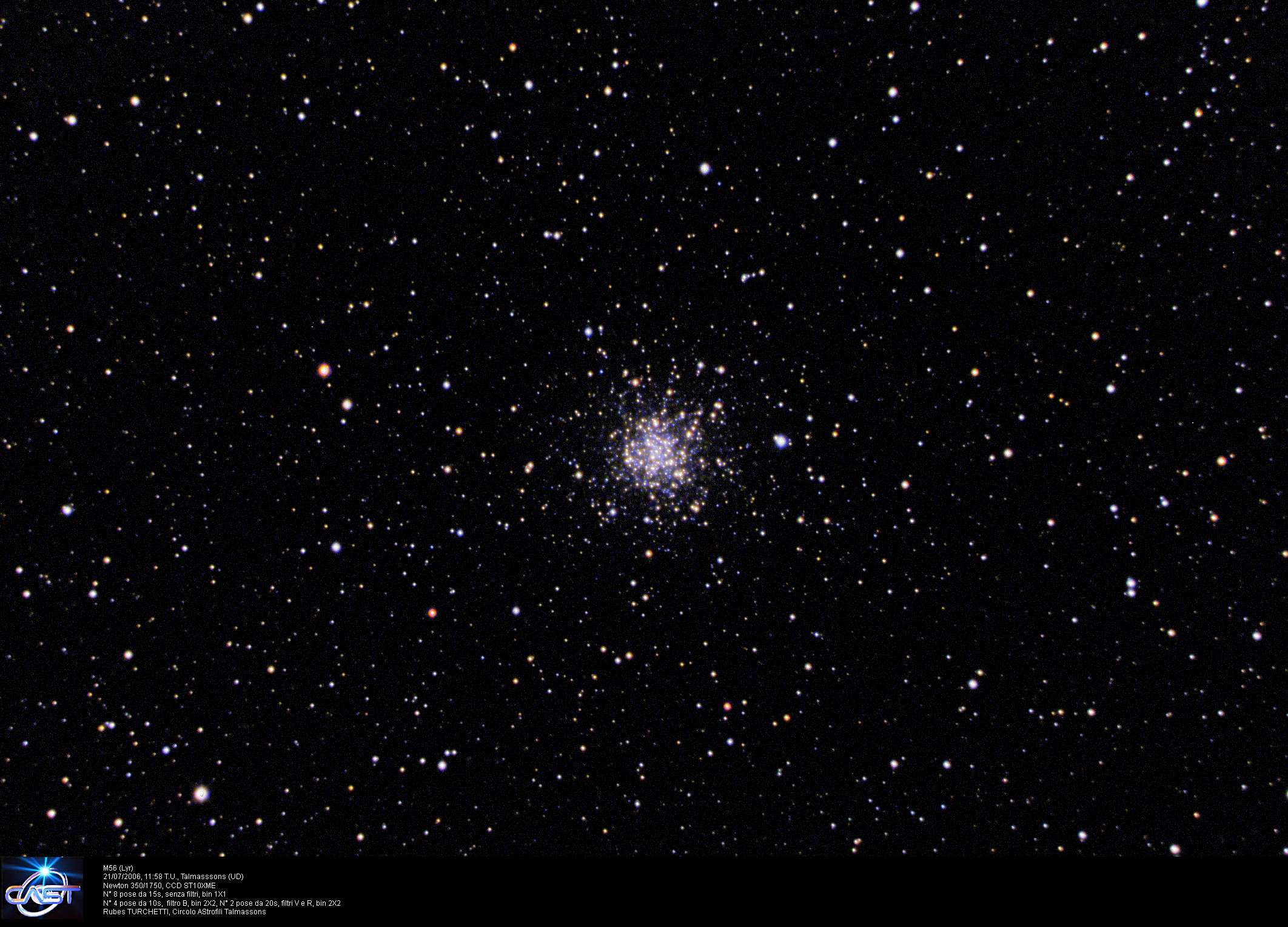 |
21/07/2006 21:58 T.U. |
Immagine di Rubes TURCHETTI |
Ripresa dall'Osservatorio Astronomico di Talmassons (Ud) |
Sezione Deep Sky |
 | ||||
| AMMASSO GLOBULARE M 56 - NGC 6779 | ||||
| Altre classificazioni: GCL 110 | ||||
| Tipo: X ; Catalogo NGC: glob. cl., B, L, iR, gvmCM, rrr, st 11...14; = M | ||||
| Ascensione retta: 19h 16m 35.5s; declinazione: +30° 11' 05" (J2000.0) | ||||
| Asse maggiore: 5.00 minuti d'arco; magnitudine: 8.3 | ||||
| Distanza 17.200 kp | ||||
Seconda immagine dell'ammasso globulare M 56-NGC 6779, situato nella costellazione della Lira (LYRA-LYR): è una ripresa ccd a colori di Rubes Turchetti ottenuta nel luglio 2006, tre anni dopo quella di Ligustri. M 56 è un oggetto poco ripreso dagli astrofili, forse per la sua relativamente bassa luminosità complessiva (è di ottava magnitudine), oltre perché i suoi "gemelli" M 13 e M 15 sono più luminosi e compatti.
Nella nuova immagine qui presentata le stelle sono meglio definite, vista la risoluzione del nuovo ccd, e il "senso di profondità" è decisamente maggiore.
Nell'inquadratura si vede chiaramente che la densità stellare cresce enormemente andando verso il centro dell'ammasso globulare e che gli astri sono di
diverso colore a causa della diversa temperatura superficiale, dovuta ai parametri fisici della stella. Alcune stelle appaiono doppie (se lo sono solamente
prospetticamente o fisicamente non lo posso dire). Se cliccherete sull'immagine l'aprirete a 2124 x 1528 pixel e l'ammirerete a piena risoluzione.  Di seguito riporto alcune delle note rintracciate sul Guide 8.0.
Note dal Catalogo NGC2000:
Commenti dalle Osservazioni di Steve Coe:
Commenti tratti dal SAC (Saguaro Astronomy Club) 7.2:  Quest'immagine ha una dimensione di 834 x 600 pixel, è a 16,8 milioni di colori, occupa una dimensione di 18,5 MB qui compressi a 298 KB. La risoluzione è di 2,4"/pixel e la dimensione dell'immagine originale (in archivio) è di 2.314 KB. | ||||
| Telescopio Riflettore: Newton da 350 mm di diametro; lunghezza focale: 1750 mm; f/5 | ||||
| CCD: Sbig ST0XME | ||||
| Tempo d'integrazione Luminanza: somma di 8 pose da 15 secondi in binning 1x1 | ||||
| Tempo d'integrazione crominanza Blu: somma di 4 pose da 10 secondi in binning 2x2 | ||||
| Tempo d'integrazione crominanze Verde e Rossa: somma di 2 pose da 20 secondi in binning 2x2 | ||||
| Filtri impiegati: Cousins (rosso) e Johnson (verde e blu) | ||||
| Immagine pubblicata a pagina 17 sulla rivista "Nuovo Orione" n° 184 del settembre 2007 | ||||
Ammassi |
Oggetti Messier |
Fotografia, ccd e ricerca |
Articoli |
Dizionario
| ||||
